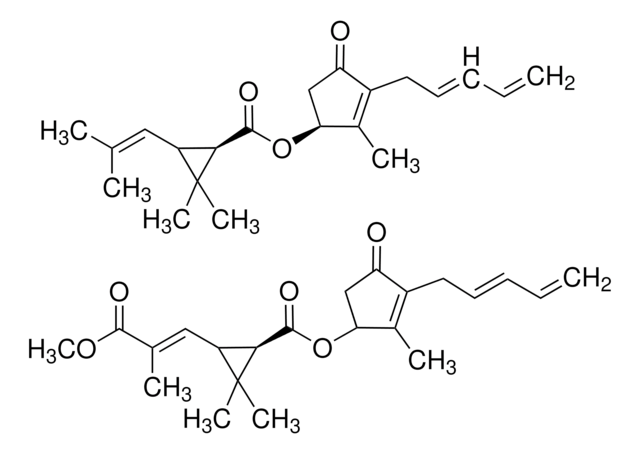291102
Piperonylbutoxide
technical grade, 90%
Synonyme(s) :
2-(2-Butoxyethoxy)ethyl (6-propylpiperonyl) ether, 4,5-Methylenedioxy-2-propylbenzyldiethyleneglycol butyl ether
About This Item
Produits recommandés
Qualité
technical grade
Niveau de qualité
Pureté
90%
Indice de réfraction
n20/D 1.498 (lit.)
Point d'ébullition
155 °C/0.3 mmHg (lit.)
Solubilité
water: slightly soluble 0.0289 g/L at 20.4 °C
Densité
1.059 g/mL at 25 °C (lit.)
Groupe fonctionnel
ether
Chaîne SMILES
CCCCOCCOCCOCc1cc2OCOc2cc1CCC
InChI
1S/C19H30O5/c1-3-5-7-20-8-9-21-10-11-22-14-17-13-19-18(23-15-24-19)12-16(17)6-4-2/h12-13H,3-11,14-15H2,1-2H3
Clé InChI
FIPWRIJSWJWJAI-UHFFFAOYSA-N
Vous recherchez des produits similaires ? Visite Guide de comparaison des produits
Description générale
Mention d'avertissement
Warning
Mentions de danger
Conseils de prudence
Classification des risques
Aquatic Acute 1 - Aquatic Chronic 1 - Eye Irrit. 2 - STOT SE 3
Organes cibles
Respiratory system
Risques supp
Code de la classe de stockage
10 - Combustible liquids
Classe de danger pour l'eau (WGK)
WGK 3
Point d'éclair (°F)
339.8 °F - closed cup
Point d'éclair (°C)
171 °C - closed cup
Équipement de protection individuelle
Eyeshields, Gloves
Faites votre choix parmi les versions les plus récentes :
Déjà en possession de ce produit ?
Retrouvez la documentation relative aux produits que vous avez récemment achetés dans la Bibliothèque de documents.
Les clients ont également consulté
Notre équipe de scientifiques dispose d'une expérience dans tous les secteurs de la recherche, notamment en sciences de la vie, science des matériaux, synthèse chimique, chromatographie, analyse et dans de nombreux autres domaines..
Contacter notre Service technique




![2,2′-Methylenebis[6-(2H-benzotriazol-2-yl)-4-(1,1,3,3-tetramethylbutyl)phenol] 99%](/deepweb/assets/sigmaaldrich/product/structures/236/824/ce89085c-b9e1-4ea0-8157-44b6f9466ed6/640/ce89085c-b9e1-4ea0-8157-44b6f9466ed6.png)











